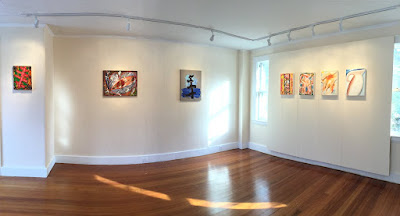Carol Heft is a gifted artist. What we get in her work is the tip of the iceberg. Smoke on the water. Somewhere there are flares and fire; somewhere, someplace gets burned to the ground. We might sense that, but completely unconsciously. Instead we luxuriate in the smoke; we see across the water.
 |
Carol Heft, Untitled, 2016, on paper, 18x24",
collage w/ watercolor, gouache, charcoal, pencil |
For 40 plus years Carol Heft has contemplated this place in painting. Cy Twombly may have opened the door, but Carol Heft was already there. Who knows how? It was a dream. On the water.
 |
Carol Heft, Untitled, 2016, on paper, 18x24",
collage w/ watercolor, gouache, charcoal, pencil |
I watched her contemplating this dream through the end of a cigarette in our studio on Benefit Street at RISD. It was the shiny swell of the late 70s, and we were just battered art students with a headful of dreams. A few years later I read the scrawls on her studio walls on the Bowery on New York's Lower Eastside. We were at the bottom of the heap but we were in it, up to our eyeballs, and that was all that mattered. So much has changed since then, but that remains true.
 |
Carol Heft, Untitled, 2016, on paper, 18x24",
collage w/ watercolor, gouache, charcoal, pencil |
Back at the very beginning, however, it was drawing and then printmaking that helped Carol Heft etch out the faint outlines of what could be. That was the power and magic of suggestion at the beginning. The raw and contemplative that would define her work forever. Poetry was at the heart of it. Poetry that could make out a golden kingdom in a wisp of smoke, when prose was just signage on the New Jersey Turnpike. Poetry that could sink a well that gushed to the heavens, when prose would just let you down. Prose that could only get you close, but never there. Poetry that could do it all and carry you to the top, when prose just ended up proving that more was sadly less.
 |
Carol Heft, Untitled, 2016, on paper, 18x24",
collage w/ watercolor, gouache, charcoal, pencil |
But there is so much more. Carol Heft is so much more. What you see is not what you get. At first. Carol Heft's depth, her raw and contemplative power, is actually matched by a surprise, by her sense of humor. Her wisecracking sense of humor. Her troublemaking, mischievous, irreverant sense of humor. It follows her around like a nuisance, like a terrier. Yipping. It can spoil her so serious and so sincere moments. The little devil that keeps those heavens on their toes. The little devil that keeps it real.
 |
Carol Heft, Untitled, 2016, on paper, 18x24",
collage w/ watercolor, gouache, charcoal, pencil |
So when her work seems too touchy feely, too heartfelt to believe, look around. Something is at play. Somewhere there is a giggle. Somewhere there is a guffaw! As she scratches her way to heaven, humor is the tail to her kite. As she carves up the wind, something else is afoot. Something else lurks. Some true delight curled inside the smoke.
 |
Carol Heft, Untitled, 2016, on paper, 18x24",
collage w/ watercolor, gouache, charcoal, pencil |
Carol Heft is a fabulous painter, and maybe you get that, but the key to her magic, to her exuberance, is her fabulous sense of humor. Those of us who have been within that blast radius, doubled over by it, consider ourselves lucky indeed, and cherish the true radiance and value of her work.
Addison Parks
Carol Heft: Work on Paper
THE BLUE MOUNTAIN GALLERY
The Blue Mountain Gallery is pleased to announce an exhibition of work by Carol Heft from March 1 – 26, 2016. The exhibition will include collage, drawing, painting, digital images, and constructions in a variety of materials. Ms. Heft’s work is inspired by an exploratory approach to materials, and the interchange of two and three dimensional space on flat surfaces. Her new work combines physical and illusionary layers of space populated by imaginative formal combinations. Careful attention to composition born of random arrangements are juxtaposed in compelling designs.
Born in 1954, Carol Heft studied painting with Robert Brackman, National Academician, from the age of 12 – 16. She then attended the Rhode Island School of Design where she studied with Lisa Chase, Leland Bell, Judy Pfaff, and other visiting artists and instructors. After graduating in 1976, Ms. Heft moved to New York City, where she currently lives and works. Carol Heft teaches drawing, painting, 2 dimensional design, and technical drawing at Muhlenberg College, and Cedar Crest College, in Allentown PA, and St. Joseph’s College in Brooklyn, NY. Contact Marcia Clark at the gallery for further information






















